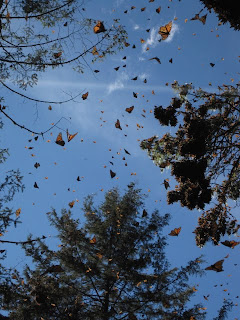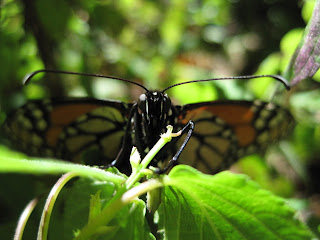Still the experience in Pacific Grove did not prepare me for what we saw on Cerro Pellón, part of the Reserva de la Biosfera de la Mariposa Monarca near Zitácuaro, a few hours from Mexico City. I am lousy at estimating vast numbers but I am sure there were millions of butterflies, maybe hundreds of millions. They weigh down the tall fir trees in huge clumps, they fill the air and cover the ground. You can hear their combined flapping and it sounds like wind or waves or fire. Most insect swarms are horrifying, but a swarm of monarchs is something joyous, fascinating, bordering on the divine.
We spent the night before in Zitácuaro, a friendly town with delicious bread. We stayed at the comfortable Hotel América run by Abel Rivera, a very sweet and helpful man, who instead of trying to get us involved in some sort of tour, told us the best way to get out to the butterflies by public transportation. We made it to the bottom of the mountain by nine and hired a compulsory guide named Pascual. He was nice enough, but after he told us that Cerro Pellón was 10,000 meters high I stopped asking him a lot of questions.
He took us to a beautiful mountain meadow in a pass below the peak where we set up our tent. In October when the butterflies first arrive in Mexico they would have been above our meadow, but now in February they have moved lower. We walked back down with Pascual, who left us at the the trail to the hollow where the butterflies had congregated. He offered to come get us in the morning but we told him not to bother. That night when we got back to camp our headlamps and some food were missing. We didn't see anyone else that day except for a couple of rangers near the butterflies. We are from the U.S. so for us Pascual is innocent until proven guilty, but in Mexico it's the other way around.










We spent the entire afternoon sitting and staring or wandering among the butterflies, and I told Hilary what my kids and I had learned studying them. They come from as far away as Canada. Those west of the Rockies fly to California and winter in places like Pacific Grove and Santa Cruz. Those from east of the Rockies come to Mexico, some of them flying more than 4000 miles. They return to the same trees each year, but incredibly these butterflies are the great-grandchildren, the great-great-grandchildren, or even the great-great-great-grandchildren of the butterflies that left the year before. No one knows what makes it possible, but it happens.
During the summer a monarch, like most butterflies, has a short life, less than two months. But the generation that flies south in October can live four times that long. They were just starting to mate while we were there. They continue to mate into March after which the males die and the females make part of the journey back north before laying eggs and dying. It isn't until the second, third, or fourth generation that they make it back to their northernmost spots.
Each generation starts as an egg on a milkweed plant. The egg hatches into a caterpillar that grows fat and somewhat poisonous (to eat) on the milkweed leaves. The poison stays with them through the rest of their lives. The caterpillar molts several times as it grows larger. After a couple weeks, when the caterpillar is ready to pupate, it hangs upside down under a leaf attaching itself with silk. It molts one last time. Its new skin is a shiny green shell called a chrysalis. Contrary to the teachings of The Very Hungry Caterpillar most butterflies pupate in a chrysalis, not a cocoon, which is common among moths.
In the chrysalis, as I understand it, the caterpillar liquefies and in two weeks or less re-forms as a butterfly. When it breaks out of the chrysalis its wings are wadded up and useless. Soon, however, a fast hardening liquid pumps through vessels in the wings and gives them their strength and form. A few times my students and I were able to watch viceroy butterflies, whose colors mimic the monarch, complete their metamorphosis in my classroom. It was always a big hit.




































The next picture is of a female butterfly. The following is a male. You can tell the difference between the male and the female because the male has two bulges or spots in its black stripes on its wings on either side next to its abdomen.


























In the night we lay sleepless for several hours in our tent without our missing headlamps to read by. But I was entertained when I closed my eyes by the ghostly movements of the butterflies dancing behind my eyelids the way fireworks do when I close my eyes on the night of the Fourth of July.
The next morning we passed back through the butterfly area on our way down the mountain. It was still rather cold and cloudier than the day before. Many of the butterflies remained clinging to branches and each other in the fir trees. There were also thousands of dead butterflies on the ground, a testament to the brutal rains of the week before and again to fact that an abundance of life must include an abundance of death.
We stopped in a sunny field of flowers near the bottom where many monarchs were drinking nectar and flitting about. We hung out with them for half an hour or so to take a few more pictures and say goodbye. There we met a friendly shepherd named Jhon Acunción Moreno who got off his horse and talked to us for a while. He is the one who taught us the difference between the males and the females.
We planned to take a taxi and a bus back to Zitácuaro, but Hilary stuck her thumb out to the first pickup truck and the smiling cowboy-hatted driver gave us a lift all the way back to town. We picked up our things from Don Rivera who gave us the warmest of goodbyes and directed us to a wonderful trout restaurant called La Trucha Alegre (The Happy Trout). I can't speak for the trout but I was happy, as was the baby, Tonantsín, of proprietress Isabel.









After lunch we boarded a bus to Morelia, still astonished by our visit to the butterflies. Take a look:

3 comments:
This is amazing you guys!! I've never seen so many butterflies all about together! Really beautiful.
Visions of a Hitchcock film. That was both beautiful and creepy.
Wow. I've heard about that, but never seen so many pictures. It's on my life list, but thanks for the preview! It sounds like a tremendous experience.
Bummer about the headlamps though...
Post a Comment